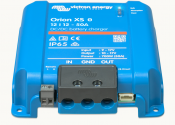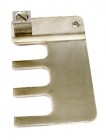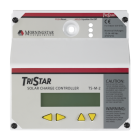 Loading... Please wait...
Loading... Please wait...Categories
Add to Wish List
You Recently Viewed...
New Products
-
$472.00
-
$289.00
-
$2,389.00
-
$76.00
-
$79.00
Our Newsletter
- Home
- Solar Charge Controllers
- TS-45 Morningstar 45A 12/24/48V Solar Charge PWM Controller
TS-45 Morningstar 45A 12/24/48V Solar Charge PWM Controller
Product Description
Morningstar’s TriStar Controller is a three-function controller that provides reliable solar battery charging, load control or diversion regulation. The controller operates in one of these modes at a time and two or more controllers may be used to provide multiple functions.
The TriStar uses advanced technology and automated production to provide exciting new features at a competitive cost. The optional TriStar meter is the most sophisticated and informative controller meter on the market. The controller is UL listed and is designed for both solar home systems and professional applications.
Features
Highest Reliability
Large heat sink (1) and conservative design enables operating at full ratings to 60°C. No need to de-rate.
More Power
Ratings to 60A at 48VDC will handle solar arrays up to 4kW.
Communications Capability
RS-2312 (2) connects to a personal computer for custom settings, data logging and remote monitoring and control.
Fully Adjustable
DIP switch (3) provides user with a choice of 7 different digital presets and custom settings via RS-232.
Extensive Electronic Protections
Fully protected against reverse polarity, short circuit, overcurrent, high temperature and overvoltage.
Simple Mechanical Interface
Larger power terminals (4) and conduit knockouts (5). Extra space for wire turns. Fits on power panels.
Better Battery Charging
Connecting battery sensor wires (6) and optional remote temperature sensor (7) will improve control accuracy. Constant voltage series PWM algorithm increases battery capacity and life.
More Information
3 LED’s (8) to indicate status, faults and alarms.Optional meter (9) displays extensive system and controller information, automatic self-test and reset capabilities. Meter connection via RJ-11 phone jack (10).
Easy to Reset
Pushbutton (11) provides manual reset and stop/start battery equalization or load disconnect.
Low Telecom Noise
DIP switch setting will change PWM to "On-Off" battery charging.
Specifications
Electrical
| TriStar-45 | TriStar-60 | |
|---|---|---|
| Rated solar, load or diversion current: | 45 Amps | 60 Amps |
| System Voltage | 12-48V | |
| Accuracy | 12/24V: 0.1% +/-50mV 48V: 0.1% +/-100mV |
|
| Min. voltage to operate | 9V | |
| Max. solar voltage (Voc) | 125V | |
| Self-consumption: | Controller > 20mA Meter 7.5mA |
|
Environmental
-
Operating ambient temperature: Controller –40°C to +60°C Meter –40°C to +60°C - Storage temperature: –55°C to +85°C
- Humidity: 100% (non-condensing)
- Tropicalization: Conformal coating on both sides of all printed circuit boards
Electronic Protections
- Reverse polarity protection (any combination)
- Short-circuit protection
- Overcurrent protection
- Lightning and transient surge protection using 4500W transient voltage suppressors
- High temperature protection via automatic current reduction or complete shut down
- Prevents reverse current from battery at night
TriStar Options:
- Digital Meters
Two digital meters can be added to the TriStar at any time during or after installation. One version is mounted on the controller (TS-M), the other is suitable for remote locations (TS-RM):
- TriStar Meter (TS-M) — 2 x 16 display mounts to controller and provides system and controller information, data logging, bar graphs and choice of 5 languages
- TriStar Remote Meter(TS-RM) — Includes 30 meters of cable for mounting meter away from the controller
The display is a 2x16 LCD meter with backlighting. Four pushbuttons are used to scroll through the displays and to execute manual functions. There are a series of display screens that provide information such as:
- operating information and data
- operating bar charts (voltage and current)
- alarms and faults
- diagnostics
- settings
In addition, there are various manual functions built into the meter. For example, the meter can be used to reset Ah data or start/stop equalizations. One of 5 languages can be selected for the meter.
- Remote Temperature Sensor
Provides temperature compensated charging by measuring temperature at the battery (10 meter cable)
If the temperature of the system battery varies more than 5°C (9°F) during the year, temperature compensated charging should be considered. Because the battery’s chemical reactions change with temperature, it can be important to adjust charging to account for the temperature effects. The RTS will measure the battery temperature, and the TriStar uses this input to adjust the charging as required.
The battery charging will be corrected for temperature as follows:
12 V battery 0.030 Volts per °C (–0.017V per °F) 24 V battery 0.060 Volts per °C (–0.033V per °F) 48 V battery 0.120 Volts per °C (–0.067V per °F) The RTS should be used only for battery charging and diversion control. Do not use the RTS for load control. The charging parameters that are adjusted for temperature include:
- PWM regulation
- Equalization
- Float
- High Voltage Disconnect
Mechanical
-
Dimensions: Height: 26.0cm/10.3 inch Width: 12.7cm/5.0 inch Depth: 7.1cm/2.8 inch - Weight: 1.6 kg/3.5 lb
- Largest Wire: 35mm2/2 AWG
- Conduit Knockouts: Eccentric 2.5/3.2 cm (1.0/1.25 inch)
- Enclosure: Type 1, indoor rated
Certifications
- CE Compliant
- UL Listed (UL 1741)
- cUL (CSA-C22.2 No.107.1-95)
- Complies with U.S. National Electric Code
- Manufactured in a certified ISO 9001 facility
Detailed Description
Versions
There are two standard versions of TriStar controllers:
TriStar-45:
- Rated for maximum 45 amps continuous current (solar, load or diversion load)
- Rated for 12, 24, 48 Vdc systems
TriStar-60
- Rated for maximum 60 amps continuous current (solar, load or diversion load)
- Rated for 12, 24, 48 Vdc systems
To comply with the National Electric Code (NEC), the current rating of the controller for solar charging must be equal or greater than 125% of the solar array’s short circuit current output (Isc). Therefore, the maximum allowable solar array input to the TriStar controller for compliance with the NEC is:
| TS-45: | 36 amps Isc |
| TS-60: | 48 amps Isc |
Operating Modes:
There are three distinct and independent operating modes programmed into each TriStar. Only one mode of operation can be selected for an individual TriStar. If a system requires a charging controller and a load controller, two TriStars must be used.
Charge Control/Solar Battery Charging

The energy output of a solar array is used for recharging the system battery. The TriStar manages the charging process to be efficient and to maximize the life of the battery. Charging includes a bulk charging stage, PWM absorption, float and equalization.
- Constant voltage series PWM design to provide highly efficient battery charging
- 4-stage charging to increase battery capacity and life: bulk charge, PWM regulation, float and equalize
- Parallel for larger solar arrays up to 300 amps or more
Load & Lighting Control

When set for load control, the TriStar powers loads from the battery, and protects the battery from over-discharge with a current compensated LVD (low voltage load disconnect). Lighting control is a special function of Load control where the load is switched On and Off based on the solar array voltage.
- Starts large loads including motors and pumps with no damage to controller
- Allows inrush current to 300 amps
- Electronic short-circuit and overload protection with automatic reconnect
- LVD is current compensated and has a delay to avoid false disconnects
Diversion Charge Control

In diversion mode, the TriStar will manage battery charging by diverting energy from the battery to a dedicated diversion load. The energy source is typically wind or hydro.
- May be used for solar, wind or hydroelectric
- To protect against battery overcharge, excess energy is diverted from primary battery to a secondary battery or alternate DC resistive load
- PWM reduces power into diversion load during overcurrent conditions
Adjustability
Eight DIP switches permit the following parameters to be adjusted at the installation site:

| DIP switch | Solar Battery Charging |
|---|---|
| 1 | Battery charge control mode |
| 2-3 | Select battery voltage |
| 4-6 | Standard battery charging programs |
| 7 | Manual or automatic equalization |
| 8 | PWM charging or on-off charging |
| DIP switch | Load & Lighting Control |
| 1 | DC load control mode |
| 2-3 | Select battery voltage |
| 4-6 | LVD/LVR settings or lighting programs |
| 7 | not used for load control |
| 8 | enable/disable Lighting Control |
| DIP switch | Diversion Charge Control |
| 1 | DC load control mode |
| 2-3 | Select battery voltage |
| 4-6 | Standard diversion charge control programs |
| 7 | Select diversion charge control mode |
| 8 | Manual or automatic equalization |
In addition to the DIP switches, the TriStar provides for additional adjustments using a PC program. An RS-232 connection between the TriStar and a personal computer will enable extensive adjustments using PC software from Morningstar’s website.
General
The TriStar is suitable for a wide range of solar applications including homes, telecom and industrial power needs.
TriStar controllers are configured for negative ground systems. There are no parts in the controller’s negative leg. The enclosure can be grounded using the ground terminal in the wiring compartment.
The TriStar is protected from faults electronically with automatic recovery. There are no fuses or mechanical parts inside the TriStar to reset or change. Solar overloads up to 130% of rated current will be tapered down instead of disconnecting the solar. Over-temperature conditions will also taper the solar input to lower levels to avoid a disconnect.
The NEC requires overcurrent protection externally in the system. There are no system disconnects inside the TriStar enclosure.
Any number of TriStars can be connected in parallel to increase solar charging current. TriStars can be paralleled ONLY in the battery charging mode. DO NOT parallel TriStars in the load mode, as this can damage the controller or load.
The TriStar enclosure is rated for indoor use. The controller is protected by conformal coated circuit boards, stainless steel hardware, anodized aluminum, and a powder coated enclosure, but it is not rated for corrosive environments or water entry.
The construction of the TriStar is 100% solid state.
Battery charging is by a series PWM constant current charging, with bulk charging, PWM absorption, float and equalization stages.
The TriStar will accurately measure time over long intervals to manage events such as automatic equalizations or battery service notification.
Day and night conditions are detected by the TriStar, and no blocking diodes are used in the power path.
LED’s, a pushbutton, and optional digital meters provide both status information and various manual operations.
The date of manufacture can be found on the two bar code labels. One label is on the back of the TriStar, and the other is in the wiring compartment. The year and week of manufacture are the first four digits of the serial number:
| year | week | seria# |
|---|---|---|
| 03 | 36 | 0087 |
Safety and Regulatory Information
The TriStar controller is intended for installation by a qualified technician according to electrical rules of each country in which the product will be installed.
TriStar controllers comply with the following EMC standards:
- Immunity: EN61000-6-2:1999
- Emissions: EN55022:1994 with A1 and A3 Class B1
- Safety: EN60335-1 and EN60335-2-29 (battery chargers)
A means shall be provided to ensure all pole disconnection from the power supply. This disconnection shall be incorporated in the fixed wiring. Using the TriStar grounding terminal (in the wiring compartment), a permanent and reliable means for grounding shall be provided. The clamping of the earthing shall be secured against accidental loosening. The entry openings to the TriStar wiring compartment shall be protected with conduit or with a bushing.
FCC requirements:This device complies with Part 15 of the FCC rules. Operation is subject to the following two conditions:
- This device may not cause harmful interference
- this device must accept any interference received, including interference that may cause undesired operation. Changes or modifications not expressly approved by Morningstar for compliance could void the user’s authority to operate the equipment.
PWM Battery Charging
PWM (Pulse Width Modulation) battery charging is the most efficient and effective method for recharging a battery in a solar system. Refer to "Why PWM?" on Morningstar’s website for more information.
Selecting the best method for charging your battery together with a good maintenance program will ensure a healthy battery and long service life. Although the TriStar’s battery charging is fully automatic, the following information is important to know for getting the best performance from your TriStar controller and battery.
- Bulk Charging: In this stage, the battery will accept all the current provided by the solar system. The LED’s will display an indication of the battery charge state as the battery is being recharged.
- PWM Absorption: When the battery reaches the regulation voltage, the PWM begins to hold the voltage constant. This is to avoid over-heating and over-gassing the battery. The current will taper down to safe levels as the battery becomes more fully charged. The green LED will blink once per second.
- Equalization: Many batteries benefit from a periodic boost charge to stir the electrolyte, level the cell voltages, and complete the chemical reactions. The green LED will blink rapidly 2-3 times per second.
- Float: When the battery is fully recharged, the charging voltage is reduced to prevent further heating or gassing of the battery. The green LED will blink slowly once every 2 seconds.
Battery Charging Notes
The TriStar manages many different charging conditions and system configu rations. Some useful functions to know follow below.
- Solar Overload: Enhanced radiation or "edge of cloud effect" conditions can generate more current than the controller’s rating. The TriStar will reduce this overload up to 130&37; of rated current by regulating the current to safe levels. If the current from the solar array exceeds 130&37;, the controller will interrupt charging.
- Battery Voltage Sense: Connecting a pair of voltage sense wires from the controller to the battery is recommended. This allows a precise battery voltage input to the controller and more accurate battery charging.
- Temperature Compensation: All charging setpoints are based on 25°C (77°F). If the battery temperature varies by 5°C, the charging will change by 0.15 volts for a 12 volt battery. This is a substantial change in the charging of the battery, and a remote temperature sensor is recommended to adjust charging to the actual battery temperature.
- Day-Night Detection: The TriStar will automatically detect day and night conditions. Any functions that require measuring time or starting at dawn, for example, will be automatic.
- PWM Noise: In some installations, the PWM charging may cause audible noise in certain equipment. If this occurs, the PWM can be changed to "On- Off" solar charging to reduce the noise. This requires DIP switch number 8 to be turned On. However, it is strongly recommended to try to remedy the noise problem with grounding or filtering first, because the benefits from PWM battery charging are significant.
- Battery Types: The TriStar’s standard battery charging programs are suitable for a wide range of lead-acid battery types.
Warranty: Five year warranty period. Contact Morningstar for complete terms.










